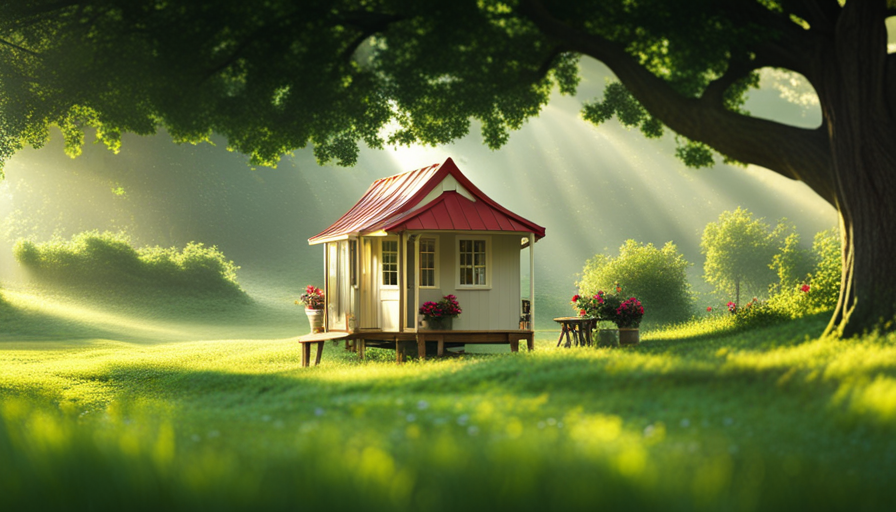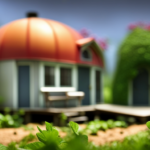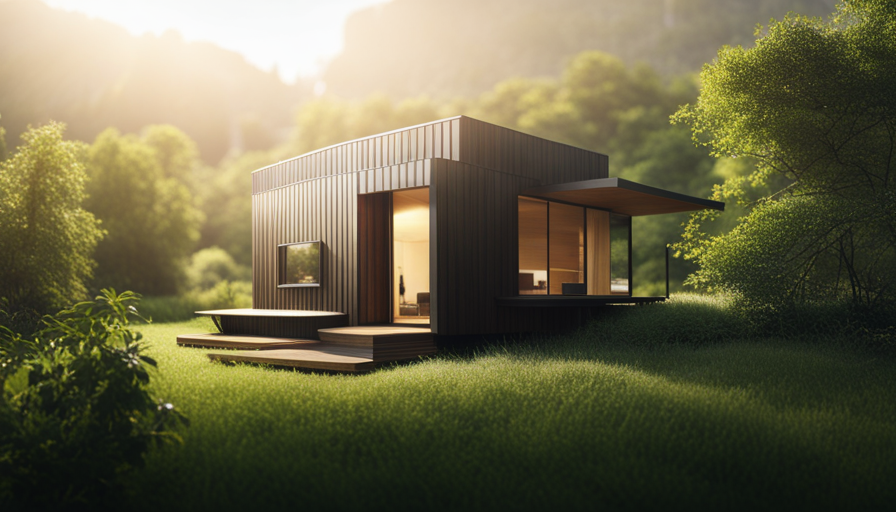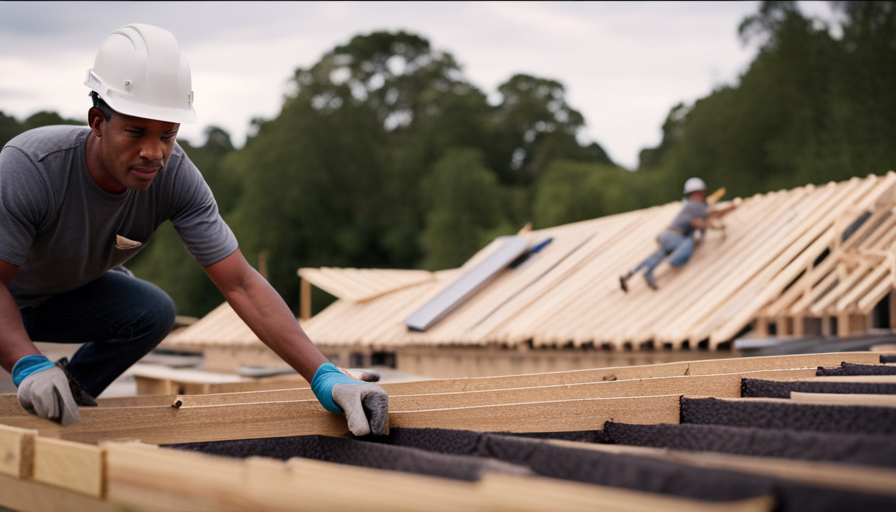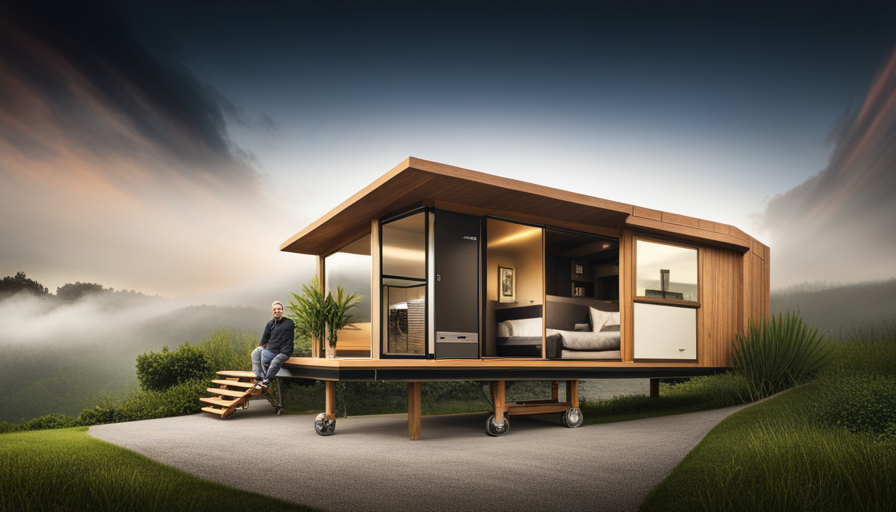Welcome to the tiny house movement – a trend that is changing our living habits and having a positive impact on our planet! This article will explore how tiny homes offer a practical solution to environmental problems.
Tiny houses, with their tiny footprint, offer tremendous benefits that go beyond their compact size. Through energy efficiency, reduced carbon emissions, minimal resource consumption, and sustainable living practices, these pint-sized abodes play a significant role in preserving our planet for future generations.
By embracing a minimalist lifestyle, tiny house dwellers are able to reduce their carbon footprint and live more sustainably. The compact size of these homes encourages energy efficiency, as they require less energy for heating, cooling, and lighting. With fewer square feet to heat or cool, tiny house owners can significantly reduce their energy consumption and the associated carbon emissions.
Moreover, the construction of tiny houses often involves the use of recycled and repurposed materials, further minimizing resource consumption. Additionally, their eco-friendly design incorporates features like rainwater collection systems and solar panels, allowing homeowners to harness renewable energy sources.
Join us as we delve deeper into the many ways a tiny house can help protect our environment, and discover how these small dwellings can make a big difference in our quest for a sustainable future.
Key Takeaways
- Tiny houses promote energy efficiency and reduce energy consumption through their compact size and excellent insulation.
- Many tiny houses use recycled and repurposed materials, minimizing resource consumption and waste management.
- Tiny houses often incorporate sustainable features like rainwater collection systems and solar panels, reducing reliance on fossil fuels.
- Living in a tiny house encourages a simpler lifestyle and reduces excessive consumption, leading to a lower environmental impact.
Energy Efficiency
Living in a tiny house allows for greater energy efficiency, making it easier to reduce your carbon footprint and save money on utility bills. These small dwellings are designed with energy-saving features that maximize the use of natural resources.
For example, many tiny houses are equipped with solar panels, allowing residents to generate their own electricity from renewable sources. These panels can power the entire house, including appliances and heating systems. Additionally, tiny houses often have excellent insulation, reducing the need for artificial heating and cooling. The compact size of these homes also minimizes energy loss, as there are fewer areas for air leakage.
Furthermore, many tiny houses are built with energy-efficient appliances and fixtures, such as LED lighting and low-flow faucets, further reducing energy consumption. By integrating renewable energy and implementing energy-saving features, tiny houses significantly decrease the amount of energy required to power a home. This not only benefits the environment by reducing carbon emissions, but it also helps homeowners save money on their utility bills.
With reduced energy consumption and a smaller carbon footprint, living in a tiny house is a sustainable choice for a greener future.
Reduced Carbon Emissions
By opting for a tiny home, individuals significantly cut down on their carbon footprint, making a positive impact on the planet. Tiny houses are known for their energy efficiency, but they also contribute to reduced carbon emissions in other ways.
One of the key factors is the use of renewable energy sources. Many tiny homes are equipped with solar panels, allowing residents to generate their own clean and sustainable energy. By harnessing the power of the sun, homeowners can reduce their reliance on fossil fuels and minimize their carbon emissions.
In addition to renewable energy sources, tiny homes promote transportation alternatives. With limited space, tiny house owners often choose to live in communities that are walkable or bike-friendly. This encourages residents to rely less on cars, which are a major source of carbon emissions. By utilizing public transportation or opting for eco-friendly modes of transportation such as biking or walking, tiny house dwellers further reduce their carbon footprint.
By reducing carbon emissions through the use of renewable energy sources and transportation alternatives, tiny homes play a significant role in mitigating climate change.
In the next section, we will explore how these homes also contribute to minimal resource consumption without compromising on comfort or functionality.
Minimal Resource Consumption
With their eco-friendly features, tiny homes shine as beacons of sustainability, offering a glimpse into a world where we can embrace comfort and functionality while treading lightly on our planet. One of the key benefits of tiny houses is their minimal resource consumption.
Due to their small size, these homes require fewer materials to build and maintain, resulting in significant cost savings and reduced environmental impact.
Tiny houses have a small footprint, both in terms of physical space and resource usage. They typically range from 100 to 400 square feet, compared to the average American home size of around 2,600 square feet. This compactness not only reduces the amount of land required for construction but also minimizes the need for heating, cooling, and lighting. With less space to heat or cool, tiny homes consume less energy, resulting in lower utility bills and a smaller carbon footprint.
Additionally, the limited square footage of tiny houses promotes a simpler lifestyle, encouraging individuals to prioritize their needs over excessive consumption. This shift towards a more minimalist approach not only reduces resource consumption but also promotes a sense of mindfulness and contentment. By living in smaller spaces, we can reduce our ecological impact and create a more sustainable future.
With minimal resource consumption and cost savings, tiny houses offer a compelling solution to reducing our environmental impact. Transitioning to smaller, more efficient living spaces is a crucial step towards creating a sustainable and eco-friendly society.
Lower Environmental Impact
Embrace the eco-friendly lifestyle of a tiny home and witness a remarkable reduction in your environmental footprint. One of the key benefits of living in a tiny house is the significantly lower environmental impact it has compared to traditional homes.
Tiny houses require fewer resources to build, resulting in reduced waste management throughout the construction process. With the smaller size, fewer raw materials are needed, reducing the strain on natural resources. Additionally, the compact design encourages efficient use of energy and water, further minimizing the environmental impact.
In terms of waste management, tiny houses promote a more sustainable approach. With limited space, individuals are encouraged to adopt a minimalist lifestyle, reducing the accumulation of unnecessary possessions. This mindset extends to waste as well, as individuals become more conscious of their consumption habits and strive to minimize waste generation. Recycling and composting are also commonly practiced in tiny house communities, further reducing the need for landfill space.
Transitioning into the subsequent section about sustainable living practices, it is clear that tiny houses provide a solid foundation for embracing a more eco-friendly lifestyle. By reducing waste management and encouraging resource conservation, tiny houses pave the way for sustainable living practices that benefit both individuals and the environment.
Sustainable Living Practices
Living sustainably means making choices that support the well-being of our planet and future generations, and what better way to do that than by hopping on the tiny home bandwagon? One of the key aspects of sustainable living in a tiny house is effective waste management. With limited space, tiny homeowners are forced to be mindful of their waste production. They often adopt practices like composting and recycling to minimize their environmental impact. Additionally, many tiny homes are equipped with innovative waste management systems, such as composting toilets, to further reduce water consumption and waste production.
Another important aspect of sustainable living in a tiny house is the use of renewable energy sources. Many tiny homeowners opt for solar panels to power their homes, reducing their reliance on fossil fuels. These solar panels can generate enough energy to meet the needs of the household, while also reducing carbon emissions. Some tiny homes even have the ability to generate more energy than they consume, allowing homeowners to sell excess energy back to the grid.
By incorporating waste management practices and renewable energy sources, tiny homes are taking significant steps towards sustainable living. In the next section, we’ll explore how these eco-friendly practices are further enhanced through thoughtful design choices.
Eco-Friendly Design
Make the conscious choice to design your tiny home with eco-friendly features that not only benefit the planet but also create a harmonious and sustainable living space for you. Incorporating green materials and passive heating techniques can greatly contribute to the overall environmental impact of your tiny house.
-
Use green materials: Opt for sustainable materials like bamboo or reclaimed wood for your flooring, walls, and furniture. These materials are renewable and have a lower carbon footprint compared to traditional options. Additionally, consider using low VOC paints and finishes to minimize indoor air pollution.
-
Passive heating: Maximize natural heat sources by strategically placing windows to allow for ample sunlight. This will not only provide warmth during colder months but also reduce the need for artificial heating. Additionally, consider installing insulation and weatherstripping to prevent heat loss and increase energy efficiency.
-
Energy-efficient appliances: Invest in energy-efficient appliances such as solar-powered water heaters, LED lighting, and low-flow fixtures. These appliances consume less energy, reducing both your environmental impact and utility bills.
By incorporating these eco-friendly design elements into your tiny house, you can create a space that promotes sustainable living while minimizing your carbon footprint.
Frequently Asked Questions
Are tiny houses suitable for all climates and weather conditions?
Tiny houses can be suitable for all climates and weather conditions with the right insulation and durability measures. Proper insulation helps regulate the interior temperature, keeping the house warm in colder climates and cool in hotter climates. Additionally, durable construction materials and techniques ensure that tiny houses can withstand severe weather conditions such as strong winds and heavy rain.
Overall, with proper insulation and durability, tiny houses can provide comfortable living spaces in any climate or weather.
How do tiny houses handle waste management, such as sewage and garbage?
In terms of waste management, tiny houses have various options for sewage treatment and waste disposal. They can utilize composting toilets, which convert human waste into compost that can be used as fertilizer.
Additionally, some tiny houses may connect to municipal sewage systems or use septic tanks for proper sewage treatment.
For garbage disposal, tiny house owners can minimize waste by practicing recycling, composting, and reducing consumption.
Overall, these waste management practices in tiny houses promote sustainability and environmental responsibility.
Can tiny houses be connected to renewable energy sources like solar panels or wind turbines?
Renewable energy integration is a key aspect of off-grid living in tiny houses. According to a study by the U.S. Department of Energy, 64% of tiny house owners use solar panels as their primary energy source. This statistic highlights the growing trend of incorporating renewable energy into tiny house design. By harnessing the power of solar panels or wind turbines, tiny house owners can reduce their reliance on fossil fuels and minimize their environmental impact.
This sustainable approach aligns perfectly with the environmentally-friendly ethos of tiny house living.
What are the zoning and legal regulations surrounding owning and living in a tiny house?
Zoning regulations and legal restrictions play a crucial role in owning and living in a tiny house. These regulations vary from place to place, so it’s important to research and comply with local laws.
Zoning regulations dictate where tiny houses can be located, such as on private property or in designated communities.
Legal restrictions may include minimum square footage requirements, permits, and inspections.
Understanding and adhering to these regulations ensures a smooth and legal experience with tiny house living.
How do tiny houses contribute to community building and social sustainability?
Tiny houses contribute to community building and social sustainability through community engagement and social integration. These small homes encourage a sense of togetherness and shared spaces, fostering a strong sense of community. Residents often participate in community activities, such as gardening or shared meals, promoting social interaction and connection.
Additionally, tiny houses can be built in existing communities, revitalizing underutilized areas and promoting sustainable urban development. Overall, tiny houses offer a solution for creating inclusive and connected communities.
Conclusion
In conclusion, living in a tiny house offers numerous environmental benefits. By embracing energy-efficient technologies and sustainable living practices, such as composting toilets and rainwater harvesting, tiny house dwellers significantly reduce their carbon footprint.
Moreover, the minimal resource consumption and eco-friendly design of these homes further contribute to a lower environmental impact. It’s like a drop of water creating ripples of positive change, as tiny houses exemplify a solution-oriented approach towards a greener future.
Hi, I’m Emma. I’m the Editor in Chief of Tiny House 43, a blog all about tiny houses. While tree houses are often associated with childhood, they can be the perfect adult retreat. They offer a cozy space to relax and unwind, surrounded by nature. And since they’re typically built on stilts or raised platforms, they offer stunning views that traditional homes simply can’t match. If you’re looking for a unique and romantic getaway, a tree house tiny house might just be the perfect option.

